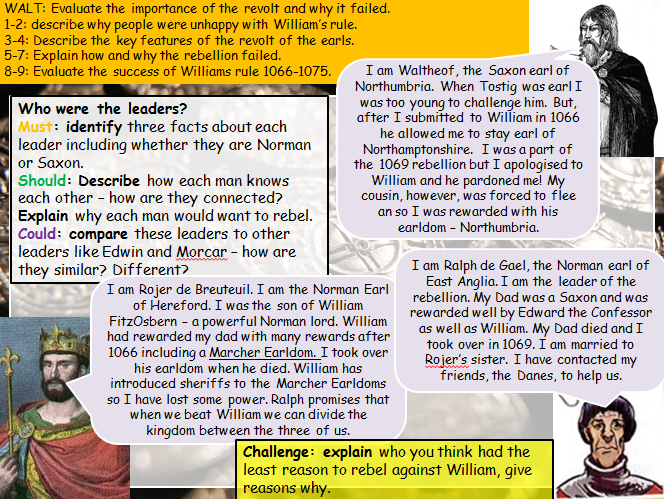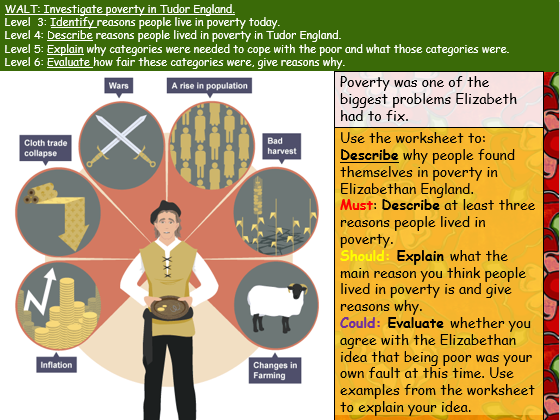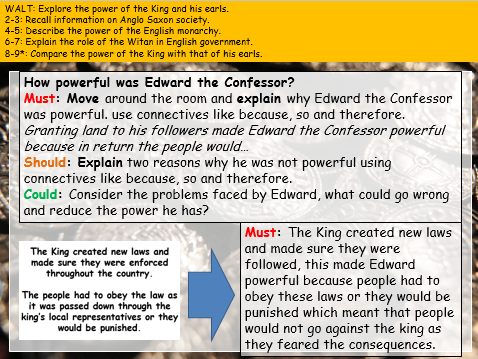
177Uploads
76k+Views
24k+Downloads
All resources
Bundle

What is History? KS3 introduction to history
This scheme of work has been created to introduce and embed historical skills across KS3.
Pupils explore key concepts such as chronology, bias, and interpretations before conducting their own investigation over a series of six lessons.
The seventh lesson of the series can be used as a baseline assessment and is in line with the interpretation skills included in Paper 3 (edexcel 9-1).

Baseline Assessment (What is history? (KS3))
This baseline assessment follows the conclusion of the ‘What is history’ scheme of work that can be found in my tes shop. It is set up to mimic the question types of Paper 3 Edexcel 9-1.
This assessment includes all interpretation type questions - 3b, 3c, 3d.

Ice Mummy Interpretation Skills Lesson (What is history? (KS3))
This lesson follows a pupil led investigation in which they discover what has happened to the ice mummies - this lesson builds upon this knowledge and develops skills of working with interpretations prior to baseline assessment - this lesson is part of a series of lessons that build upon use of sources, interpretations and finally a baseline assessment. These can be found separately or as part of a bundle in my tes shop.
WALT: apply knowledge of the Ice Maiden to interpretations about what happened to her.
L3: Recall key facts about the Ice Maiden.
L4: Describe what an interpretation is and how a historian creates it.
L5: Create an interpretation about what happened to the Ice Mummy.
L5-6: Analyse interpretations that we will use in our assessment to plan why we agree and disagree with them.

I'm a Historian! Ice Mummies Investigation (What is history? (KS3))
This lesson is set up as a pupil led investigation, pupils explore the ‘cave’ to find as much evidence as possible before they run out of time. They then have to use they evidence they have been able to collect to work out what has happened to the Mayan ice mummmy - this lesson is part of a series of lessons that build upon use of sources, interpretations and finally a baseline assessment. These can be found separately or as part of a bundle in my tes shop.
WALT: Investigate the mystery of the ice mummies to come to a conclusion.
L3: identify questions historians need to ask in order to learn about the past.
L4-5: describe key features of the ice mummies and explain what you can learn about the ice mummies from the sources and what clues might mean.
L6: hypothesise what might have happened to the ice mummies.
L6: Create a narrative account analysing the experiences of the Ice Maiden and how she felt.

Source utility (What is history? (KS3))
This lesson builds on knowledge gained during the BIAS (WHAT IS HISTORY (KS3)) lesson which is available in my TES shop.
WALT: use sources to explore Mayan culture and explain how they are useful to a historian.
L3: Recall key facts we learnt last lesson about the Mayans.
L4: describe two things you can infer from a source.
L5: explain why sources written by the Spanish are limited to a historian.
L6: Evaluate sources written by the Spanish to explain why they are useful as well as limited.
Pupils use sources to develop skills to analyse utility. Pupils are provided by WAGOLLs and heavy support to enable them to access the skill - worksheets are available for LA, MA and HA.

Chronology (What is history? (KS3))
Pupils explore the concept of chronology and how it supports historical learning, they are also introduced to the concept of a turning point and identify turning points in their own lives/across history. Includes a chronological order game of significant events from history.
WALT: define chronological order and apply this skill to historic events.
L3: Define what the term chronological means.
L4: create a timeline of events from history in chronological order.
L5: Explain what a turning point is.
L6: Apply skills to a timeline of my own life and evaluate the biggest turning point in my life so far.

'What is history?' introductory lesson (What is History? (KS3))
The first lesson in a scheme of work designed to introduce KS3 pupils to the concept of history and help them acquire historical skills.
WALT: identify key historical skills and explain why history is important.
L3: Define what the study of history is.
L4: Describe key skills a good historian needs.
L5: Explain why history is important.
L6: compare history to another subject and justify which you think is most important.
Pupils define what history is in their own words.
Investigation of blooms words, describe, explain, infer etc.
Discussion of what history is, prior learning and a video.
Lesson includes homework for pupils to complete, teacher can use homework to gain a baseline of pupils ability.

Weimar and Nazi Germany Timeline and Lesson (Edexcel 9-1)
Timeline with sections for pupils to create - worksheet to support.
Fully differentiated lesson to go alongside the timeline.
Starter: structure of Paper three
task one: overview video
Task two: timeline - defining key words, describing key events and extension task
Whiteboard AFL
Task Three source work - why vote for hitler? challenge: making links to key events on the timeline
Task designed as an introductory lesson to paper three to give pupils an overview of the topic so assumes no prior knowledge but could also be used as a revision task.

Revolt of the Earls 1075 (Anglo-Saxon and Norman England (Edexcel 9-1))
WALT: Evaluate the importance of the revolt and why it failed.
1-2: describe why people were unhappy with William’s rule.
3-4: Describe the key features of the revolt of the earls.
5-7: Explain how and why the rebellion failed.
8-9: Evaluate the success of Williams rule 1066-1075.

Hereward the Wake and the rebellion at Ely (Anglo-Saxon and Norman England (Edexcel 9-1))
WALT: Explain what caused the Ely rebellion and why it failed.
1-2: recall and describe key features of previous rebellions studied.
3-4: Describe the role of Hereward the Wake in the Ely rebellion.
5-7: Explain the causes, main developments and consequences of the Ely rebellion.
8-9: Evaluate how and why the Ely rebellion failed.
Pupils will:
starter: complete choice of two exam questions, green pen and improve/attempt other exam question if full marks.
discussion: why the fens at Ely? link back to Gate Fulford.
Worksheet task: explain key features of the rebellion, link back to 1068 and 1069 rebellions
Explain task: why did the rebellion fail?
exam question: how far did you agree, exam plan and sentence starters.

The Battle of Stamford Bridge (Anglo-Saxon and Norman England (Edexcel 9-1))
WALT: Examine the events of the Battle of Stamford Bridge and evaluate its significance.
1-2: Identify pros and cons for Harold travelling to York.
3-4: Describe the events of the Battle of Stamford Bridge.
5-7: Explain why Harold was able to claim victory.
8-9: Evaluate the significance of the Battles of Gate Fulford and Stamford Bridge.
Pupils evaluate whether Harold should have travelled to York before watching a video that examines the events of Stamford Bridge (Video worksheet included) they then explain the main reason that they think Harold won the battle before evaluating the impact the battle may have on the Battle of Hastings.

The Rising Against Tostig Godwinson (Anglo-Saxon and Norman England (Edexcel 9-1))
WALT: Evaluate the reasons and response to the rebellion against Tostig.
2-3: Recall key facts about the role of an earl.
4-5: Describe reasons Saxons did not like Tostig.
6-7: Explain why factors would make somebody rebel.
8-9*: evaluate whether Harold was right to exile his brother.
Pupils will recall the roles of an earl for the starter.
They will then go through each of the reasons the Saxons hated Tostig (printable handout that pupils highlight and annotate)
They write a letter to Harold (LA) or a response from Harold (HA) explaining why they are upset/ how they are going to offer help
They analyse the impact this had upon Harold’s claim and whether he was right to exile his brother.

The Power of the Godwin Family and Normandy Embassy (Anglo-Saxon and Norman England (Edexcel 9-1))
WALT: Evaluate the power of the Godwin family.
2-3: Recall key facts about the Godwin family.
4-5: Describe the importance and power of the Godwins in England.
6-7: Explain what happened during Harold’s embassy to Normandy and why it might cause problems.
8-9*: analyse how useful Norman sources are to a historian.
Pupils examine the power of the Godwins and how their influence both helped and hindered Edward’s rule
They then explore the Normandy embassy using the Bayeux tapestry and the Norman and Saxon interpretation of the event.

Anglo-Saxon Local Govenment (Anglo-Saxon and Norman England (Edexcel 9-1))
WALT: Examine the government of Saxon England at a local level.
2-3: Identify and define key words.
4-5: Describe the role of the Shire Reeve.
6-7: Explain how the legal system works in Anglo Saxon England.
8-9*: Evaluate the impact of collective responsibility.
Bundle

KS3 Elizabeth I
Full scheme of work consisting of 9 lessons exploring the reign of Elizabeth I.
All lessons fully differentiated and designed to embed skills required for the reformed GCSE’s.
Topics in order of teaching are:
Who was Elizabeth?
Who should marry Elizabeth?
Poverty and the poor laws
Education
Entertainment
Mary Queen of Scots - whats the problem?
Mary Queen of Scots - plots and execution
Armada - causes
Armada - events narrative account

Elizabethan England: Poverty and the Poor Laws
WALT: Investigate poverty in Tudor England.
Level 3: Identify reasons people live in poverty today.
Level 4: Describe reasons people lived in poverty in Tudor England.
Level 5: Explain why categories were needed to cope with the poor and what those categories were.
Level 6: Evaluate how fair these categories were, give reasons why.

Elizabethan England: What caused the Spanish Armada? (Skills lesson)
This skills lesson is aimed to encouraged independent extended writing - pupils examine the causes of the armada before reading and annotating a WAGOLL that demonstrates how to reach level 7 at KS3. They then create their own piece analysing the reasons Philip launched the Armada.
WALT: Explain why Phillip launched the Armada
Level 3: identify more than one cause of the Spanish Armada.
Level 4: describe each cause in detail.
Level 5: Explain why each cause upset Phillip enough for him to launch his Armada.
Level 6-7: Evaluate the importance of causes to reach a judgement.

Elizabethan England: Events of the Spanish Armada 1588 (Narrative Account skills lesson)
WALT: Explain why Phillip launched the Armada
Level 3: identify key features of weapons used during the battle.
Level 4: describe the events of the battle in detail.
Level 5: Explain why Elizabeth won the battle.
Level 6-7: Evaluate the reasons for the victory and which part of the narrative was most important.
Bundle

KS3 WW2 bundle
This unit of work has been created to embed and develop skills required at KS4 within KS3 written responses. Skills developed include source work (Interpretations and sources) as well as narrative account, consequences, and PEEL paragraphs.
Bundle includes lessons about:
D-Day
Defeat of France
Hitler’s defeat
Invasion of Poland
Operation Barbarossa
Pearl Harbour
The Blitz
WW2 Dictators

Kings and Earls comparison (Edexcel 9-1: Anglo Saxon and Norman England)
This lesson has been designed to embed comparison skills needed for the 16 mark question in paper two Anglo-Saxon and Norman England.
Pupils will:
WALT: Explore the power of the King and his earls.
2-3: Recall information on Anglo Saxon society.
4-5: Describe the power of the English monarchy.
6-7: Explain the role of the Witan in English government.
8-9*: Compare the power of the King with that of his earls.
Tasks include:
a carousel
comparison worksheet in which pupils catagorise their ideas and develop comparative thought.
16 mark question with support for PEEL paragraph structuring.
AFL and differentiation throughout




















